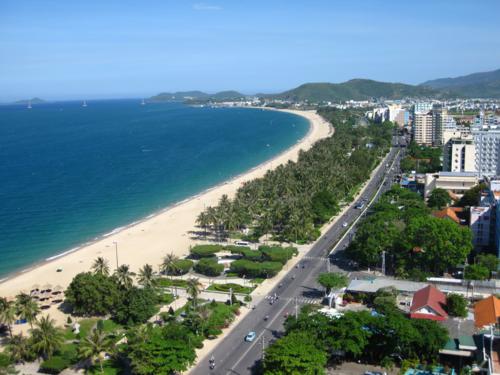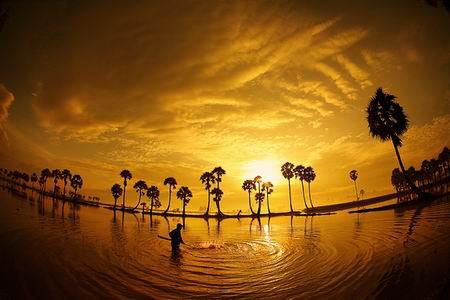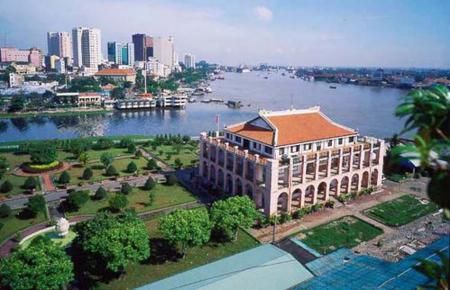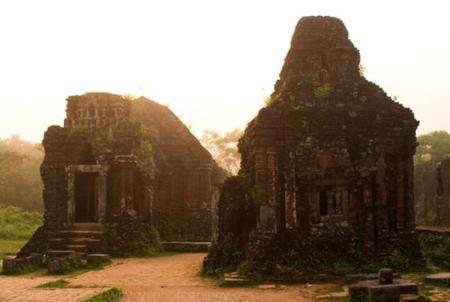6. Nha Trang
Located on one of Asia’s most beautiful bays off the coast of South Central Vietnam, Nha Trang is a popular seaside resort city. Picturesque mountains, beaches and lush islands all make it a favorite destination among tourists, Vietnamese and scuba divers.
Adorned with resorts, palm trees and a lovely promenade, Nha Trang’s beach is its main draw. As a popular stopover for sea cruises and annual Hong Kong yacht races, Nha Trang and its beach offer plenty of water activities such as scuba diving, snorkeling, kite boarding, sailing and catamaran rides. Amusement and water parks provide fun for everyone with roller coasters and wave pools.
Within the city of Nha Trang, tourists can visit a few important landmarks like pagodas, the Nha Trang Cathedral and the historic Po Nagar Cham Towers. The Nha Trang Oceanography Institute is home to an aquarium housing thousands of ocean creatures. Just outside the city, tourists can enjoy river boat cruises and explore the picturesque countryside, fishing villages, plantations, waterfalls and natural hot springs.
Dining choices in Nha Trang are abundant for every budget and taste from casual sidewalk cafes to high end restaurants. The city’s cuisine is known for its seafood dishes as well as bird’s nest soup and barbecued pork rolled in rice paper. Bars, lounges and clubs provide plenty of nightlife options.
Nha Trang is easy to explore by walking and cycling, but tourists can also get around by buses, taxis, motorbikes and cyclos (three-wheeled motorised vehicles).
7. Mekong Delta
Colorful floating markets, fruit orchards, rice paddies, sugar cane groves, bird sanctuaries and quaint villages are all what draw many to the Mekong Delta in southwestern Vietnam. Nicknamed “Vietnam’s Rice Basket”, the Mekong Delta is an agricultural region made fertile by the maze of canals and streams fed by the Mekong river. Stretching from the Gulf of Thailand to Ho Chi Minh City, the Mekong Delta feeds more than a third of the country from its rich plantations, orchards, rice paddies and fish farms.
With plenty of bus connections and motorbikes, tourists can explore the Mekong Delta and its towns like Tra Vinh, which is considered one of the prettiest villages of the delta. Many towns in the region provide shops, restaurants and hotels for travelers. Others places like Hon Chong, feature attractions like pictorial stone grottoes, while Ben Tre is dominated by fruit orchards, Sa Dec is rife with colorful flower farms, and Cao Lanh is a paradise for bird lovers. The beautiful island of Phu Quoc offers scuba diving, snorkeling, kayaking and hiking. Just outside Chau Doc, Sam Mountain presents temples and lovely views. A river boat cruise in Vinh Long brings tourists to a floating market teeming in busy workers and fresh produce and fish. Read Travel Mekong Delta in flooding season.
8. Ho Chi Minh City
Lying along the Saigon River near the Mekong Delta in southern Vietnam, Ho Chi Minh City was formerly known as Saigon and served as the capital of South Vietnam during the Vietnam War. Today, Ho Chi Minh City is the largest city of the reunified country, offering plenty of reasons to visit, from its blend of historic and modern attractions to vibrant shopping, dining and nightlife.
Ho Chi Minh City is most commonly explored by motorbike taxis, but buses and car taxis are also plentiful. Sightseeing the city’s center awards elegant boulevards lined with French colonial architecture, beautiful churches, pagodas and prominent landmarks like the Reunification Palace, City Hall, the Opera House and Notre Dame Cathedral. A number of museums exhibit war history and local culture.
The city’s business and entertainment district offer modern attractions like the Bitexco Financial Tower skyscraper and the Dai Nam Tourist Park, which features a man-made mountain range, zoo, temples, hotels, shops and restaurants. The Night Market and the Ben Thanh Market are lively places to buy food, handicrafts, souvenirs and experience local food and culture. Outside the city, jungle and river tours are available to see bamboo villages and floating temples. Read our article Top 11 attractions in Ho Chi Minh city should not missed.
From market stalls to street vendors, cafes, coffee shops and international restaurants, Ho Chi Minh City offers the largest variety of dining choices in Vietnam. Local cuisine consists of traditional dishes like Pho (beef and chicken noodle soups) and Com tam (a plate of rice, grilled pork and vegetables). Nightlife in Ho Chi Minh City buzzes with a wide selection of bars, lounges, nightclubs and theaters. Find more shopping places in Saigon.
9. My Son
Located on the central coast of Vietnam near the Duy Phu Village is the important archaeological site known as My Son. One of Southeast Asia’s most notable heritage sites, My Son was once a significant center of religious Hindu ceremonies where the kings of the Champa Kingdom built numerous temples devoted to the worship of the god, Shiva, between the 4th and 14th centuries.
Believed to have once contained more than 70 temples that were constructed with brick and decorative carvings and sculptures bearing scenes of animals, priests, gods, mythical battles and inscriptions of Sanskrit and Champa, My Son today features a complex of ruins in varying states of disarray and repair, all arranged in several groups that are marked by letters of the alphabet.
Within the site is a museum where visitors can check out exhibits and artifacts to better understand and appreciate the ruins. Near the entrance of My Son are a few cafes, food vendors and a shop selling souvenirs. At certain times of the day, visitors can watch live Champa dance performances. Additionally, the site is surrounded by jungle, hills and a lake where visitors can enjoy hiking and kayaking.
My Son is often reached by organized tour groups in vans and buses from Hoi An. However, visitors can also arrive at My Son by motorbike taxis and motorbike rentals. Read Some places near Hoi An should go.
10. Da Lat
Year-round cool weather and idyllic scenery of misty valleys, lush pine trees and colorful flowers are some of the reasons that Da Lat was once used by Vietnamese emperors and French colonials as a summer retreat. Today, this charming town in the South-Central Highlands of Vietnam is a popular destination for honeymooners, weekend getaways and for those looking for relief from the heat.
A walkable city, Dalat is a beautiful scene of French colonial architecture and villas set amid picturesque landscapes. The city is well known for its royal palaces owned by the last emperor of Vietnam. These lovely palaces are open for tours as is the Hang Nga Guesthouse, the city’s most bizarre attraction. Informally called the “Crazy House”, this structure is a fantastical construction with caves, spider webs and shapes of animals and mushrooms. Dalat’s lively market is a great place to find fruits, flowers and vegetables grown in the local area as well as handicrafts and silk embroidered items.
Outside the city are scenic lakes, flower gardens, historic monasteries, plantations and mountains offering pretty waterfalls and trails for hiking and mountain biking. A must-do is the Valley of Love, an incredibly beautiful valley with pine forests, flowers and lakes where tourists can enjoy pedal-boating, horse riding, jeep safaris and Canyoning. Read Canyoning at Datanla waterfalls, Dalat city.
For dining and nightlife, Dalat offers numerous cafes and restaurants to suit every budget and taste from regional dishes to French and Western cuisines as well as a few bars and nightclubs.
Source: Vietnamnet.vn





